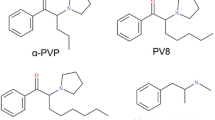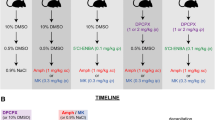Summary
The central action of oxaprotiline (OXA) enantiomers, administered in a single dose, was studied in rats and mice. (+)-OXA and (−)-OXA attenuated reserpine- and apomorphine-induced hypothermia [(+)-OXA in a more potent manner] in mice and reduced the immobility time in the behavioural despair test in rats. Both OXA enantiomers inhibited locomotor activity in mice and rats, and enhanced and prolonged amphetamine- and apomorphine-induced stereotypy in rats. (−)-OXA potentiated the amphetamine hyperactivity in rats, but not in mice. Nomifensine hyperactivity in rats was unaffected by either enantiomer, and locomotor hypoactivity induced by low doses of apomorphine was also unchanged, as was L-DOPA-induced locomotor hyperactivity in mice. Apomorphine-induced climbing in mice was attenuated by (+)-OXA. Clonidine locomotor hypoactivity and hypothermia were unchanged, and clonidine-induced aggressiveness was attenuated by (+)-OXA. Neither OXA enantiomer affected the action of oxotremorine. In some tests the effect of OXA was stronger at 3 h than at 1 h after administration. The above results indicate that both OXA enantiomers—in particular (−)-OXA—increase some dopaminergic behavioural effects in rats.
Similar content being viewed by others
References
Checkley SA, Thompson C, Burton S, Franey C, Arendt J (1985) Clinical studies of the effect of (+) and (-) oxaprotiline upon noradrenaline uptake. Psychopharmacology 87: 116–118
Delini-Stula A, Bischoff S, Radeke E (1982) Antiserotoninergic properties of maprotiline and a new antidepressant, oxaprotiline: two selective NA uptake inhibitors. Drug Dev Res 2: 543–550
Delini-Stula A, Mogilnicka E (1988) Single treatments with the antidepressant oxaprotiline and its (+) and (−) enantiomers increase behavioural responses to dopaminergic stimulation in the rat. J Neural Transm 71: 91–98
Delini-Stula A, Radeke E, Van Riezen H (1988) Enhanced functional responsiveness of the dopaminergic system—the mechanism of anti-immobility effects of antidepressants in the behavioural despair test in the rat. Neuropharmacology 27: 943–947
Delini-Stula A, Vassout A, Hauser K, Bittiger H, Büch O, Olpe H-R (1983) Oxaprotiline and its enantiomers: do they open new avenues in the research of the mode of action of antidepressants ? In: Usdin E, Goldstein M, Friedhoff A, Georgotol A (eds) Frontiers in neuropsychiatric research. Macmillan, London, pp 121–134
Kopanski Ch, Türck M, Schultz JE (1983) Effects of long-term treatment of rats with antidepressants on adrenergic-receptor sensitivity in cerebral cortex: structure activity study. Neurochem Int 5: 649–659
Maj J, Deren A, Moryl E (1989) Pharmacological effects of oxaprotiline enantiomers on the central serotonin system. Pol J Pharmacol Pharm 41 (in press)
Maj J, Mogilnicka E, Klimek V, Kordecka-Magiera A (1981) Chronic treatment with antidepressants: potentiation of clonidine-induced aggression in mice via noradrenergic mechanism. J Neural Transm 52: 189–197
Maj J, Wedzony K (1988) The influence of oxaprotiline enantiomers given repeatedly on the behavioural effects of d-amphetamine and dopamine injected into the nucleus accumbens. Eur J Pharmacol 145: 97–103
Mishra R, Gillespie DD, Lovell RA, Robson RD, Sulser F (1982) Oxaprotiline: induction of central noradrenergic subsensitivity by its (+)-enantiomer. Life Sci 30: 1747–1755
Mogilnicka E, Czyrak A, Maj J (1987) Dihydropiridine calcium chanel antagonists reduce immobility in the mouse behavioural despair test; antidepressants facilitate nifedipine action. Eur J Pharmacol 138: 413–416
Ozawa H, Miyauchi T, Sugawara K (1975) Potentiating effect of lithium chloride on aggressive behaviour induced in mice by nialamide plus L-DOPA and clonidine. Eur J Pharmacol 34: 730–732
Pawłowski L, Mazela H (1986) Effects of antidepressant drugs, selective noradrenaline- or 5-hydroxytryptamine uptake inhibitors, on apomorphine-induced hypothermia in mice. Psychopharmacology 88: 240–246
Porsolt RD, Anton G, Blavet N, Jalfre M (1978) Behavioural despair in rats: a new model sensitive to antidepressant treatment. Eur J Pharmacol 47: 379–391
Tricklebank MD, Forler C, Fozard JR (1985) The involvement of subtypes of the 5-HT1 receptor and of catecholaminergic systems in the behavioural response to 8-hydroxy- 2-(di-n-propyloamino)tetralin in the rat. Eur J Pharmacol 106: 271–282
Waldmeier PC, Baumann PA, Hauser K, Maître L, Storni A (1982) Oxaprotiline, a noradrenaline uptake inhibitor with an active and an inactive enantiomer. Biochem Pharmacol 31: 2169–2176
Wendt G (1988) Levoprotiline—clinical therapeutic efficacy and tolerability. Psychopharmacology 95 [Suppl]: 13
Author information
Authors and Affiliations
Rights and permissions
About this article
Cite this article
Maj, J., Rogóź, Z., Skuza, G. et al. Some central pharmacological effects of (+)- and (−)-oxaprotiline. J. Neural Transmission 80, 129–143 (1990). https://doi.org/10.1007/BF01257078
Received:
Accepted:
Issue Date:
DOI: https://doi.org/10.1007/BF01257078




